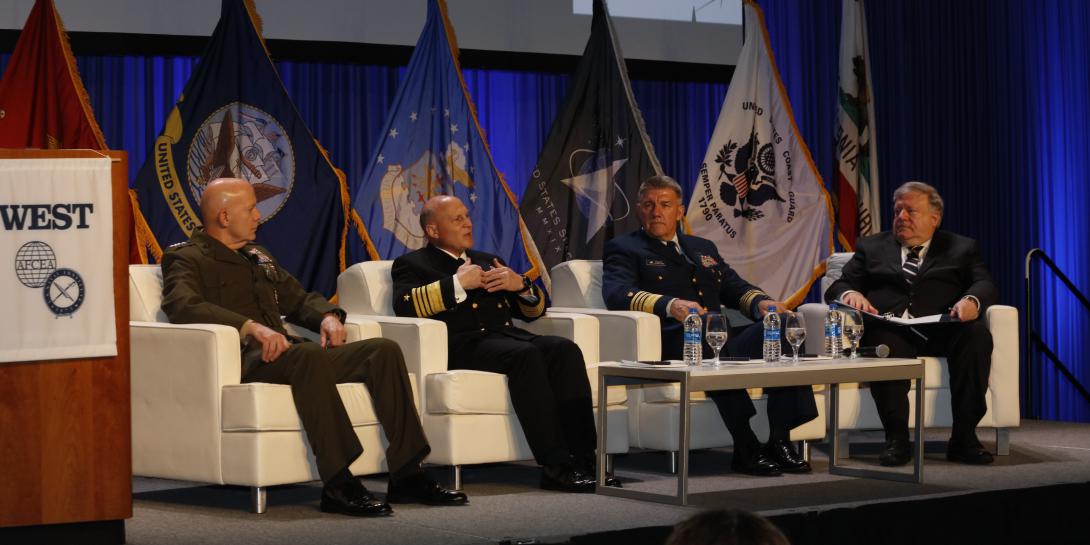Meeting the Maritime Challenge Will Require Careful Resource Allocation
The sea services face tight funding, limited assets and broader missions as they re-tool for growing and more diverse challenges around the world. Not only must they allocate their resources carefully, they also must establish new procedures with greater efficiencies so they can fulfill a larger mission set.
This was the picture drawn by the chiefs of the three sea services in the final panel discussion of WEST 2022, the conference and exposition hosted by AFCEA International and the U.S. Naval Institute in San Diego February 16-18. Attendees heard pointed remarks by Adm. Michael M. Gilday, USN, chief of naval operations; Gen. David H. Berger, USMC, commandant, U.S. Marine Corps; and Adm. Karl L. Schultz, USCG, commandant, U.S. Coast Guard. The three flag officers described the changing nature of their challenges along with the measures they are taking to carry out their missions.
Adm. Gilday was blunt about force size. “We need over 500 Navy ships, we need 12 carriers, we need a strong amphibious force,” he stated. “I’m sighted on a bigger and more powerful Navy … but we’re not taking our eye off the ball with respect to requirements.”
I’m sighted on a bigger and more powerful Navy … but we’re not taking our eye off the ball with respect to requirements.—Adm. Michael M. Gilday, USN, chief of naval operations @USNavyCNO #WEST2022
— Bob Ackerman (@rkackerman) February 18, 2022
But meeting those requirements will require funding the Navy has not yet received. So, it must make choices until such funding is possible. “When we discuss divest and invest, it really comes down to priorities,” he said. “If people agree that we need a larger and more powerful Navy, then we obviously need more resources to grow it.
“This is a tough decade for us in a difficult and challenging budget environment,” the admiral declared.
The issue of readiness has a different definition for each of the three services. Gen. Berger stated that availability is not necessarily readiness, adding, “I don’t think we’re where we want to be when we talk about readiness.” He noted that the ability of the Marines to respond to a crisis on short notice is huge, and the Corps can’t let an adversary arrive at the site of a crisis—even a natural disaster—before it does.
I don’t think we’re where we want to be when we talk about readiness. (Availability is not readiness.)—Gen. David H. Berger, USMC, commandant, U.S. Marine Corps @CMC_MarineCorps #WEST2022
— Bob Ackerman (@rkackerman) February 18, 2022
Simulation can help Marines prepare for a variety of different deployments, the general offered. “Industry can help us get the reps and sets that we need for when we have to deploy,” he said. The Corps also needs industry’s help in trying out new things. Gen. Berger emphasized that failing is not failure when it helps point you in the right direction.
“They [industry] have tremendous minds” he stated. “We need to tap into that.”
On the other hand, the Coast Guard is amid a major shipbuilding program that addresses its increased mission set. Adm. Schultz said it is preparing to both meet traditional Coast Guard tasks and assist the Navy in warfighting conditions. “We are positioning our force to be ready to support the numbered fleets,” he offered.
Adm. Schultz added that, given the Coast Guard’s missions and ongoing programs, it is seeking proven technologies. “For industry, keep the lines of dialogue open,” he stated. Some Coast Guard ships are so old that, for one icebreaker, the Coast Guard had to find a badly needed part on eBay that a contractor could purchase and sell to the service legally.
We’re looking for proven technologies. For industry, keep the lines of dialogue open.—Adm. Karl L. Schultz, USCG, commandant, U.S. Coast Guard @ComdtUSCG #WEST2022
— Bob Ackerman (@rkackerman) February 18, 2022
In the Navy, Adm. Gilday cited the need to break molds in building new ships. “We need industry to hear our pleas to move away from legacy platforms to something else,” he said. “Our shipbuilding plan is a roadmap, and it has to be clear to congress and industry.”
And the Navy must be able to extend its global reach as needed. “As for the slavish devotion to forward deployment, forward is where we need to be,” Adm. Gilday declared. “Forward is where we can make a difference.”




Comments